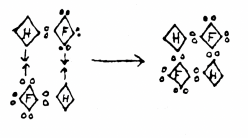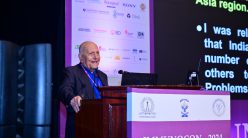Having laid the foundations for fermentation technology research in India, he is remembered for the breadth and clarity of his scientific pursuits

In 1941, a new Fermentation Technology laboratory was set up at IISc. It was something of a travelling entity, having been founded at the Department of Biochemistry and transferred at different points between the departments of Biochemistry, Pure and Applied Chemistry, and Chemical Technology and Chemical Engineering. It was even established as a separate Section at the Institute for a few years until it eventually became a part of what is known today as the Department of Microbiology and Cell Biology. However, the work carried out in this laboratory in the early years contributed significantly to the kind of research pursued by the Department of Biochemistry. And the person responsible for shaping the work done here in the early years was M Sreenivasaya, who was in charge for over a decade.
Sreenivasaya was seen as someone whose work spanned several fields including biochemistry, microbiology, plant virology and enzymology, as an intrepid researcher with multiple scientific techniques in his arsenal, and as a skilled maker of instruments. Though he is remembered for the breadth and clarity of his scientific pursuits, he is also recalled fondly as a mentor who encouraged several younger women and men in his field. A sharp writer who believed in fostering science communication, he was involved with Current Science – published by the Indian Academy of Sciences – and went on to become its Editor.
Sreenivasaya spent most of his career at IISc. He first joined the Institute as a student in 1919. According to TN Ramachandra Rao (Sreenivasaya’s former student, and a former Head of the Department of Microbiology of Fermentation Technology at the Central Food Technological Research Institute, who wrote a monograph in 1996 about Fermentation Technology at IISc), he had always been a brilliant student. Rao wrote that Sreenivasaya, who was born in Bangalore on 5 December 1895, had gone to high school in Kolar and stood first on matriculating with record marks in science subjects. But he didn’t pursue science as a field of study straight away. In 1918 he received a BA degree from Bangalore’s Central College, got married, and moved to Bombay to study law. There, he suffered a severe bout of influenza (during another large pandemic that swept through India – the Spanish Flu, which killed 50 million people across the world and an estimated 10-20 million in India) and had to give up his studies and return to Bangalore, where he lived through another tragedy – his family’s home burned down due to arson. That was when he applied to IISc.
Initially, Sreenivasaya received a scholarship from the Government of Mysore to study biochemistry (though the Department of Biochemistry would only come into being at IISc in 1921), and in particular, to study indigenous dyes, especially shellac. Eventually, Sreenivasaya was appointed Research Assistant in the Department of Biochemistry in 1922, and earned an Associateship of IISc in 1924 and a Fellowship of IISc in 1933. While at IISc, he also worked for the Government of Mysore as a consultant on lac, as supervisor in its scheme for manufacturing ragi malt, and as investigator-in-charge of the scheme on the nutrition of the silk-worm. He was deputed to Europe from 1936 to 1938, to laboratories in Sweden, Denmark and the UK, and it was on his return, according to Rao, that he decided to work in the area of fermentation.
JC Ghosh helped Sreenivasaya set up the Fermentation Technology laboratory, and CSIR funded its work in several areas
In 1940, the Board of Scientific and Industrial Research (precursor to the Council of Scientific and Industrial Research or CSIR, which came into being in 1942) was established, and JC Ghosh, IISc’s Director, was appointed a member. It had no laboratories of its own at the time, and so it sponsored projects at IISc. Ghosh helped Sreenivasaya set up the Fermentation Technology laboratory, and CSIR funded its work in the following areas: molasses, production of industrial enzymes, production of yeasts and moulds that could serve as industrial sources of vitamin D and vitamin B complex, understanding conditions favouring the increase of alcohol concentration in fermented distillery washes, cytogenetics of yeast and fungi with the aim of evolving new races, and the creation of a National Collection of Type Cultures (NCTC).
The NCTC is said to have been created in 1941 (though according to TN Ramachandra Rao, it was in 1940) on the suggestion of Shanti Swarup Bhatnagar, an Indian colloid chemist who was the first Director-General of CSIR. Sreenivasaya headed this project, which in the span of a decade collected about 2,500 cultures of interest to researchers in the fields of microbiology and biochemistry. It was the main source of microorganisms for research in Fermentation Technology at IISc. Sreenivasaya was later nominated as a member of the Permanent Committee of the Commonwealth Collection of Type Cultures in London. In 1951, the collection was transferred to the Biochemistry Division of the National Chemical Laboratory, Pune, and in 1956, it was renamed the National Collection of Industrial Microorganisms (NCIM), which even today remains one of the largest culture collections in India.

In 1941, the same year that NCTC was set up, Sreenivasaya was appointed Lecturer in IISc’s Department of Biochemistry. IISc’s Annual Report for 1941-42 mentions the construction of “a small building consisting of four cubicles for work in Fermentation Technology”, as well as the first “Lady-Students’ Hostel”, a significant development. Though the number of women students at the time was small, interestingly, a significant proportion of them studied fermentation technology or biochemistry, beginning with Kamala Sohonie (née Bhagvat), one of the first women students that Sreenivasaya supervised. She would go on to become a leading Indian biochemist herself and Director of the Royal Institute of Science, Bombay. Among the many other women to have worked in the Fermentation Technology lab were Violet Bajaj (née de Sousa, but spelled D’Souza in IISc’s records) and Indira Bhatt (née Gajjar). Bajaj came to IISc as a Research Assistant funded by CSIR, and spent most of her subsequent career working in CSIR biochemistry laboratories in Pune and Delhi. Bhatt went on to head the Department of Biochemistry, Maulana Azad Medical College, Delhi.
Sreenivasaya was known for his skills in the laboratory. “He would come to the lab at 7.30 am, lecture for an hour, and then for an hour show us a lot of techniques including glass blowing to make our own pipettes,” PR Krishnaswamy, a former student who joined the Fermentation Technology Laboratory in 1951, told Connect in February 2020. At a time when such equipment wasn’t readily available, Sreenivasaya trained his students in a range of techniques including dilatometric, conductometric and manometric methods of studying the metabolism of microorganisms; ultra-micro technique to study single cells, and simple paper chromatographic methods to determine vitamin B12 in shark liver extracts, among others, and worked with his hands to create the instruments he needed for these tasks. He developed dilatometry as a method for assaying enzymes and measuring enzyme activity, and the dilatometer he made is still spoken of in the Department of Biochemistry today.
Krishnaswamy had originally known of Sreenivasaya from reading Current Science. But as his student, he learnt about Sreenivasaya’s pioneering work, beginning in the 1920s, across multiple fields. “I was thrilled to see the equipment he had used for his earlier classic experiments in these areas,” said Krishnaswamy, “which he had carefully preserved.” He found what he learned from Sreenivasaya to be exciting and contemporary. “They were beautiful experiments that gave me an insight into life, and remain so fresh in my mind.” Krishnaswamy described his mentor as “an intellectual giant”. “His knowledge and ability to perform experiments hands-on, his knowledge of instrumentation needed for these experiments and more importantly, his ability to put all these things together to articulate an idea and execute it, was incomparable,” he said.
Sreenivasaya served on the advisory board of the journal Biochimica et Biophysica Acta alongside well-known scientists like the physicist JD Bernal and the biochemist and Nobel Laureate HA Krebs
Outside the laboratory, Sreenivasaya was associated with the South India Science Association and was deeply invested in Current Science, which, according to one of his former students, had an office situated in the Fermentation Technology and Pharmacology block. Rao wrote that he devoted himself to the task of “disseminating scientific information and news which is essential for educating the public mind to appreciate the methods, the possibilities, the blessings and the menaces of science.” Sreenivasaya was its Editor from 1942 to 1950, handing it over to his successor, the physicist GN Ramachandran. But he continued to contribute to the journal as Secretary of the Current Science Association until 1952. Sreenivasaya also served on the advisory board of the journal Biochimica et Biophysica Acta alongside well-known scientists like the physicist JD Bernal and the biochemist and Nobel Laureate HA Krebs.
During his retirement, in contrast with the care he took to preserve his equipment, Sreenivasaya reportedly took the strange step of destroying his records. According to Rao, in 1954, Sreenivasaya was invited to work at CSIR’s Central Drug Research Laboratory in Lucknow. As he planned to remain there for “a fairly long period”, he took all of his research records with him. At the end of three years, however, he developed serious health problems and was advised to return to Bangalore, which caused him to be depressed. The night before he was due to return, in despair, he “gathered all his scientific records, put them into two gunny bags and descending alone to the banks of the river [Gomati, on which the laboratory was situated], lowered them into the flowing water.” Rao continues, “We can only say ‘Gomati, give us back those records’! Thus we have lost the most important documents related to his work.” However, Rao suggests that he continued in research after this incident. Sreenivasaya passed away in 1969 at the age of 73.
Rao described his mentor as “essentially an intellectual, a clear thinker, a man of simple and frugal habits,” and as someone who, at a crucial time in India’s history, made it seem possible that Indians could be in the forefront of scientific research and give others a run for their money. He wrote that Sreenivasaya and his colleagues, “with a programme of persistent work for over a decade, ushered a new social force bent upon indigenous scientific and technological endeavour which could compete creditably with the challenge of the West.”
But perhaps one of the most endearing accounts of Sreenivasaya remains that of his former student Violet Bajaj. In an interview with Connect in 2018, at the age of 101, she laughed as she remembered how she and Sreenivasaya, “a very orthodox Kannadiga Brahmin”, would fight over the elaborate religious rituals he went through to purify himself after returning from abroad. Bajaj, an atheist from a Goan Catholic family, said, “We used to have terrific arguments about it,” but – perhaps paradoxically, by the standards of today’s times – also said that she and Sreenivasaya “got on wonderfully well”. “In the end because I always stood up to him, he respected me,” she said. She studied at IISc at a time when it was the norm for people on campus to eat in separate messes with members of their own caste and community. Bajaj, who passed away in May 2020, recounted that with time, Sreenivasaya’s beliefs on caste and purity changed, and softened enough that he was willing to step out of his comfort zone. “Later, he even came to stay at my house and ate my food,” she recalled.




